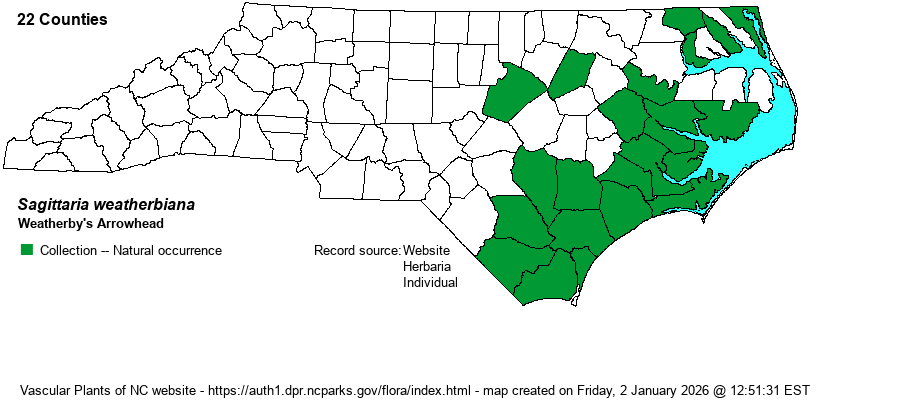| Section 5 » Family Alismataceae |
Show/Hide Synonym
| taxonName | relationship | relatedTaxonName | relatedTaxonRefText | relComments |
|---|
|
|
| Sagittaria weatherbiana | = | Sagittaria graminea var. weatherbiana | Radford, Ahles, and Bell (1968) | | | Sagittaria weatherbiana | = | Sagittaria graminea var. weatherbiana | Gleason and Cronquist (1991) | | | Sagittaria weatherbiana | = | Sagittaria graminea var. weatherbiana | Gleason (1952) | | | Sagittaria weatherbiana | = | Sagittaria graminea var. weatherbiana | Godfrey and Wooten (1979, 1981) | | | Sagittaria weatherbiana | = | Sagittaria graminea var. weatherbiana | Kartesz (1999) | | | Sagittaria weatherbiana | = | Sagittaria graminea var. weatherbiana | Wunderlin & Hansen Flora of Florida (3) | | | Sagittaria weatherbiana | = | Sagittaria graminea var. weatherbiana | Haynes, Les, & Holm-Nielsen in Kubitzki (1998b). | | | Sagittaria weatherbiana | = | Sagittaria graminea var. weatherbiana | Haynes, Les, & Holm-Nielsen in Kubitzki (1998b). | | | Sagittaria weatherbiana | = | Sagittaria graminea ssp. weatherbiana | Flora of North America (1993b, 1997, 2000, 2002a, 2002b, 2003a, 2004b, 2005, 2006a, 2006b, 2006c, 2007a, 2009, 2010) | | | Source: Weakley's Flora |
|
| Author | Fernald | |
| Distribution | Present over most of the lower half of the Coastal Plain, and ranging inland to the Fall Line in a few places (Wake and Nash counties).
This species has a fairly narrow range along the Southern Atlantic coast, from eastern VA south sparingly to northern FL. Apparently very rare south of SC. | |
| Abundance | Seems to be declining in the state, but this is uncertain. There are a minimum of 22 counties represented by specimens in collections, yet it is State Endangered, with a State Rank as supplied by the NCNHP as S2. Their database has 29 records, but only 10 are not considered as historical, and only four of these are considered of fair, good, or excellent in quality. The SERNEC database lists only Columbus, Jones, and New Hanover counties with collection dates after 1990. Considering its fairly broad habitats, most of which are not in decline, the editors see no reason for a decline, especially as all other Sagittaria species are not showing this same pattern. This website recommends only Watch List status, and a State Rank of S2S3. Clearly, more information on the current status of this species is needed. | |
| Habitat | This species occurs in a variety of shallow water and muddy situations, preferably where shady. It occurs in cypress-gum swamps, fresh to brackish marshes and tidal swamps and edges, and various other pools and pond margins. It is probably most often detected at roadsides through swamps. | |
| Phenology | This is an early flowering arrowhead, blooming from April into June, and fruiting soon after blooming. | |
| Identification | This species normally has emergent leaves that range up to 1-1.5 feet tall, with the distal third normally being a fairly elliptical blade (to about 8 inches long and 1 inch wide). The flowering scape is also about as long as the leaves, to 1-1.5 feet tall, and contains 3-8 whorls of flowers. Each flower is on a noticeably long pedicel up to 1-2 inches long. The 3 white petals form a flower than is about 1 inch across. This species is found more often in shaded or partly shaded wetlands than nearly all other Sagittaria species. Though it can have somewhat variable leaves, like so many others in the genus, it normally has a slender leaf but with a distinct narrowly elliptical blade, and an "open" inflorescence owing to the long flower stalks. At least some populations appear to be colonial, with abundant leaves closely spaced. | |
| Taxonomic Comments | As with so many others in the genus, there is a lack of agreement on its taxonomy. It formerly was named as a variety of S. graminea, as S. graminea var. weatherbiana. Most references still treat it as that, or as a subspecies (as does NatureServe) -- S. graminea ssp. weatherbiana, with a Global Rank of G5T3T4. Because Weakley (2018) treats it as a good species, the website editors need to provide a Global Rank for the species, which becomes G3G4Q.
| |
| Other Common Name(s) | None | |
| State Rank | S2 [S2S3] | |
| Global Rank | G3G4 | |
| State Status | E | |
| US Status | | |
| USACE-agcp | OBL link |
| USACE-emp | OBL link |

